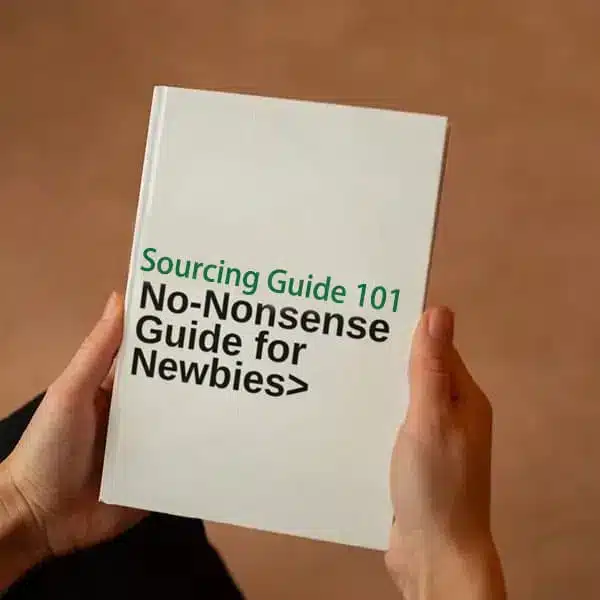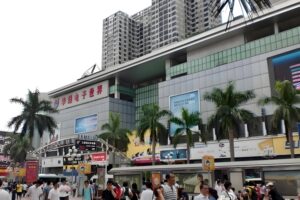Introduction – Why Research is Non-Negotiable
Alright, you’ve picked a potential product category (from Chapter 2’s ideas, perhaps?). Now comes the crucial step before you even think about contacting suppliers or spending a single dollar: thorough product research. Skipping this homework is like navigating a minefield blindfolded – you might get lucky, but the chances of hitting a costly problem are incredibly high.
Many eager entrepreneurs jump straight to sourcing, dazzled by low initial prices on platforms like Alibaba. They might find a product that looks profitable on the surface, only to discover later that shipping costs erase their margins, they lack the necessary import certifications, or the market is already saturated. Doing your due diligence upfront isn’t just recommended; it’s essential for survival and profitability. It helps you confirm if your product idea is genuinely viable, easy enough to ship, and allowed to be sold in your target market.

Let’s break down the key research areas you need to tackle before committing to an import order.
Spotting Winning Products – Principles & Discovery
Based on Chapter 2, you know product choice is king. But how do you validate if a specific product idea within that category is solid? Here are principles inspired by the original guide, but updated with fresh angles.

Principle 1: Solves a Real Problem or Fulfills a Strong Desire. Your product needs to offer genuine value. Is it making someone’s life easier, more enjoyable, or solving a nagging issue?
Example: Instead of just cosmetic storage, think about modular, stackable organizers specifically designed for popular craft supplies like Diamond Painting drills or miniature paints. This targets a passionate hobbyist group needing specific organization solutions. Ask yourself: Does my target customer genuinely need or passionately want this?
Principle 2: Offers Something Not Easily Found Locally (or Improves On It). Avoid competing head-on with big-box retailers on basic, easily accessible items (like standard t-shirts or common kitchen gadgets) unless you have a strong differentiation.
Example: Instead of generic towels, consider importing ultra-compact, quick-drying microfiber towels designed specifically for backpackers or gym-goers, perhaps in unique patterns or with built-in hanging loops – features less common in standard retail.
Principle 3:Potential for Improvement or Unique Branding1
Can you take an existing product concept and make it better, or add your unique brand identity to make it stand out?
Example: Many sell simple travel mugs. Could you offer travel mugs with integrated, temperature-controlled heating elements powered by USB-C for keeping coffee hot longer? Or offer unique, artist-commissioned designs on high-quality insulated tumblers that command a premium price. This turns a commodity into a desirable branded item.
Principle 4: Evidence of Existing (But Not Oversaturated) Demand. It’s less risky to tap into a market that already exists than to create one from scratch. Look for products with proven sales, but where there’s still room for a new player.
Example: Use tools like Google Trends to check search volume for specific terms (e.g., "sustainable dog toys" instead of just "dog toys"). Explore Amazon’s Best Seller Rank (BSR) in relevant subcategories. Tools like Jungle Scout or Helium 10 (often with free trial periods) can help analyze potential demand, competition levels, and estimated sales volume on platforms like Amazon. Look for steady interest, not just fleeting viral spikes.
Where to Discover Ideas: Beyond tools, browse niche forums (Reddit subreddits), Instagram/Pinterest trends (look for recurring aesthetics or problems), Etsy (for craft/handmade inspiration), and even Kickstarter (for innovative product concepts).
Getting Real Prices – Product Cost Research
Found a promising product? Great! Now, let’s figure out the actual cost from a Chinese supplier. The prices you see initially listed on platforms like Alibaba are often just estimates, especially for customized items.
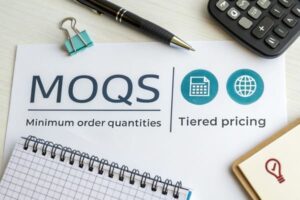
-
The Goal: Get an accurate wholesale price quote2 based on your specific requirements and order quantity.
-
Key Factor: Minimum Order Quantity (MOQ): Factories need to produce a certain number of items to make a production run worthwhile. This MOQ can vary hugely (from 50 units for some handmade items to 1000+ for complex electronics). Generally, the higher your order quantity, the lower the per-unit price.
-
Process:
- Identify Potential Suppliers: Find several (3-5) suppliers who seem capable of making your product.
- Send Detailed Inquiries: Clearly specify your product requirements (materials like hard enamel, size, specific Pantone colors, backing type, packaging).
- Ask for Tiered Pricing: Request quotes based on different quantities (e.g., their MOQ, 2x MOQ, 5x MOQ) to understand the price breaks.
- Clarify Price Terms: Understand if the price is EXW (Ex Works – you handle all shipping from their factory door) or FOB (Free On Board – they get it to the Chinese port). FOB is often easier for beginners.
-
Example (Custom Enamel Pins): You want custom-designed enamel pins for a popular tabletop gaming community.
- Supplier A quotes: MOQ 500 pcs @ $0.90/pc (FOB Ningbo)
- Supplier B quotes: MOQ 1000 pcs @ $0.75/pc (FOB Ningbo)
- Supplier C quotes: MOQ 500 pcs @ $0.80/pc (FOB Ningbo)
-
Reality Check: Compare the factory quote to the potential retail price in your market. If the custom pin costs $0.80 FOB and similar niche pins sell for $10-$12 retail online, there seems to be margin. But remember, this is JUST the product cost! (See Alibaba vs. Amazon price comparisons in the original screenshots – the principle remains the same: wholesale is much lower than retail, but many costs add up). Be wary of quotes that seem too low – quality might be compromised (e.g., soft enamel instead of hard, poor plating).
Logistics Deep Dive – Shipping & Cost Research
Getting your products from the factory in China to your doorstep (or warehouse, or Amazon FBA center) is a major cost component, especially for small businesses.
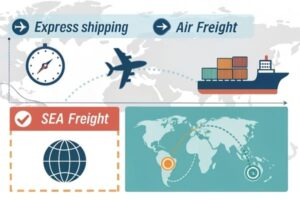
-
Main Shipping Methods:
- Express Courier (e.g., DHL, FedEx, UPS)3: Fastest (3-7 days typically), most reliable tracking, handles customs clearance easily. Best for: Small, lightweight, high-value items, samples, urgent orders. Downside: Most expensive, usually charged by weight (actual or dimensional, whichever is higher). Expect costs roughly in the $6-$10+ per kg range (highly variable!).
- Air Freight4: Faster than sea (7-15 days typically), good for moderate weight/value items. Cheaper than express but more complex (involves airport handling, customs brokers). Best for: Items needing speed but too bulky/heavy for express.
- Sea Freight5: Slowest (25-50+ days depending on route), but the most cost-effective for bulk shipments. Best for: Large volume, heavy, or non-urgent goods. Usually priced per Cubic Meter (CBM). Key Point: Often has a minimum chargeable volume (e.g., 1 or 2 CBM), making it uneconomical for very small shipments. Expect ~$200-$400+ per CBM (extremely volatile!) plus destination port fees, customs clearance, and local trucking.
- (Rail Freight): An option primarily between China and Europe/some parts of Asia. Faster than sea, cheaper than air. Less common for North America.
-
Example (Comparing Methods):
- 500 Custom Phone Grips (Small Box, maybe 5kg): Express ($6/kg * 5kg = $30) might be viable and fast. Sea freight wouldn’t make sense due to minimum volume charges.
- 200 Ergonomic Garden Tool Sets (Bulky, maybe 2 CBM total, 300kg): Express/Air would be prohibitively expensive ($1800+). Sea freight ($300/CBM * 2 CBM = $600 + fees) is the only economical option, despite the long transit time.
-
Crucial Considerations:
- Restricted Items: Some products have shipping restrictions (e.g., lithium batteries, liquids, powders, strong magnets, anything considered ‘dangerous goods’). Check if your product falls into these categories before choosing a supplier.
- Get Shipping Quotes: Ask your supplier for estimated shipping costs via different methods, OR get quotes from a freight forwarder (highly recommended for sea/air freight). They specialize in logistics and can often find better rates and handle the complexities.
Clearing Hurdles – Qualification & Compliance Research
Just because you can buy a product in China doesn’t mean you can legally import and sell it in your country or on your chosen marketplace.

-
Import Regulations: Every country has rules. You need to know:
- Product Safety Standards & Certifications6: Many product categories require specific testing and certificates to be legally sold.
- Examples: Toys often need ASTM F963 (USA) or EN71 (EU). Electronics need FCC (USA) or CE marking (EU). Food-contact items (like those travel mugs or lunch boxes) need FDA (USA) or LFGB (EU) compliance. Cosmetics have strict ingredient and labeling rules.
- Intellectual Property (IP)7: Ensure your product doesn’t infringe on existing patents or trademarks.
- Labeling Requirements: Specific information might be required on the product or packaging (e.g., country of origin, material content).
- Product Safety Standards & Certifications6: Many product categories require specific testing and certificates to be legally sold.
-
Marketplace Requirements8: Platforms like Amazon, Etsy, or Walmart Marketplace have their own additional rules and required documentation beyond legal import requirements. Selling toys on Amazon often requires submitting test reports.
-
How to Research:
- Check your government’s consumer product safety commission website (e.g., CPSC in the USA, EU directives).
- Consult your target marketplace’s seller central help pages for category-specific requirements.
- Crucially: Ask potential suppliers if they can provide the necessary and valid test reports and certificates for your target market. Don’t just take their word for it; ask to see the documents. If they can’t provide them, you may need to pay for testing yourself (which can be expensive: $500 – $4,000+ per test series).
-
Tip: If unsure, consulting with a customs broker or a compliance testing lab early on can save major headaches later.
Putting It All Together – Calculating Your Total Landed Cost
Okay, time for the moment of truth. You need to calculate the Total Landed Cost – the full cost to get one unit of your product from the factory floor into your hands (or warehouse), ready to sell.
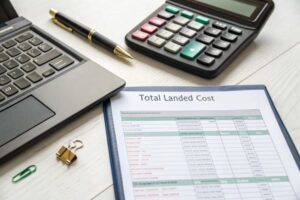
- Key Cost Components:
- Product Cost: The price per unit from your supplier (e.g., FOB price).
- Shipping Cost: International freight (express, air, or sea).
- Import Duties & Taxes9: Calculated as a percentage of the customs value (usually product cost + shipping). You’ll need the product’s HS Code to find the duty rate for your country (search your government’s tariff database or ask a customs broker). Taxes (like VAT/GST) are often applied too.
- Customs Clearance Fees10: Fees charged by the shipping carrier (for express) or your customs broker (for air/sea) to handle the import paperwork.
- Certification/Testing Costs: (Usually minimal for simple enamel pins, unless using specific materials requiring testing).
- Local Delivery: Cost to transport goods from the port/airport to your final destination (often included in express courier fees).
- (Optional but Important): Payment processing fees, potential inspection costs (if hiring a third party).
- Calculation Example (Simplified – for the Custom Enamel Pins):
- Product Cost (FOB – using Supplier C): $0.80
- Express Shipping (estimated for 500 pins, maybe 6kg): $0.07 ($42 total / 500 units)
- Import Duty (e.g., 0% for certain pin types in some countries, check YOUR HS code): $0.00
- Taxes (e.g., 10%): $0.09 (($0.80+$0.07+$0.00) * 10%)
- Customs Fee (spread per unit): $0.04
- Estimated Landed Cost per unit: $0.80 + $0.07 + $0.00 + $0.09 + $0.04 = $1.00
- Profitability Check: Now, compare this landed cost ($1.00) to your target selling price (e.g., $11.99). Factor in marketplace fees (like Etsy’s listing/transaction fees or website costs), marketing costs, and overhead. Is there still a healthy profit margin (aiming for 20-30%+ net profit is a common goal)? If the landed cost was $1.00 and you sell for $11.99, the gross margin looks very good, leaving room for fees and profit. If not, you may need to renegotiate prices, increase your selling price, increase order quantity for a lower unit cost, or reconsider the product specifics.
Conclusion
Doing thorough research before importing isn’t just paperwork; it’s the foundation of a profitable business. By diligently investigating product viability, accurately calculating costs (product, shipping, duties), and ensuring you meet all compliance requirements, you dramatically reduce your risk and set yourself up for success. Taking the time now saves significant money and stress down the road. Now you’re ready to move towards finding the right supplier!
-
Discover innovative strategies to differentiate your product and enhance its appeal through unique branding and improvements. ↩
-
Understanding wholesale price quotes is crucial for negotiating better deals with suppliers. Explore this link to learn more about the process. ↩
-
Explore the advantages of Express Courier services to understand why they are ideal for urgent and high-value shipments. ↩
-
Learn about Air Freight to see if it’s the right choice for your shipping needs, balancing speed and cost. ↩
-
Discover the cost-effectiveness of Sea Freight for bulk shipments and its suitability for non-urgent goods. ↩
-
Understanding product safety standards is crucial for compliance and avoiding legal issues when importing goods. ↩
-
Protecting your business from IP infringement is vital for legal security and maintaining your brand’s integrity. ↩
-
Knowing marketplace requirements helps you navigate selling online successfully and avoid potential pitfalls. ↩
-
Understanding import duties and taxes is crucial for accurate cost calculations and compliance. Explore this link to find detailed information for your country. ↩
-
Customs clearance fees can significantly impact your overall costs. Learn more about these fees to better manage your import expenses. ↩


